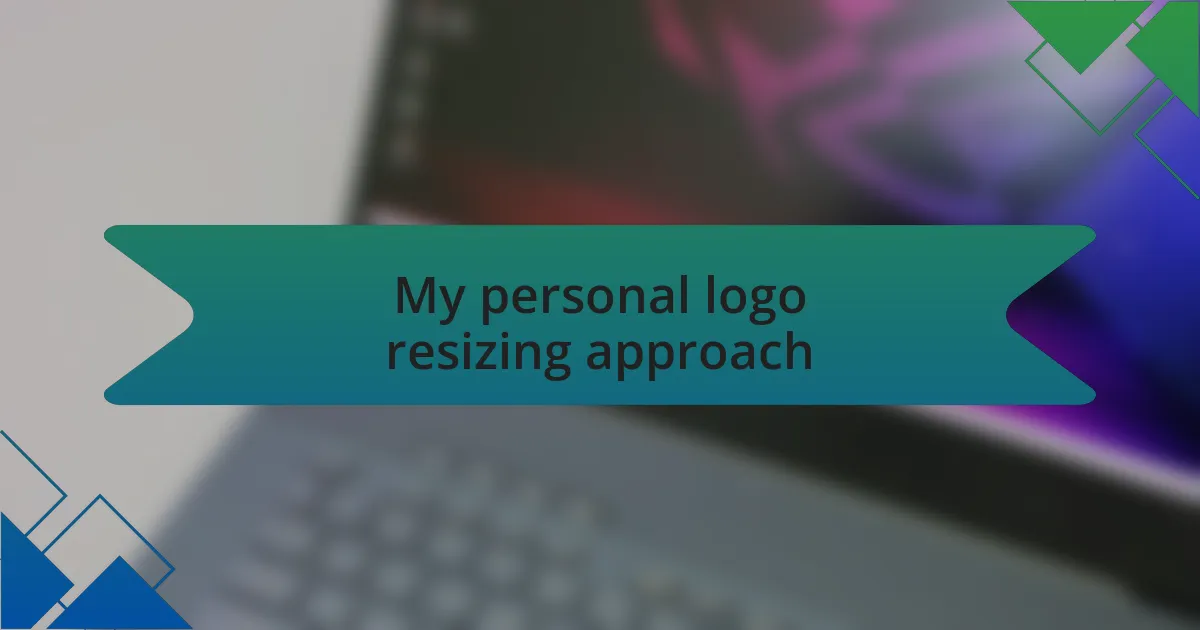Key takeaways:
- Logo resizing is crucial for maintaining brand integrity across different platforms, emphasizing the importance of color, shape, and adaptability.
- Social media icons are vital for brand engagement and recognition, requiring design consistency to reinforce online identity.
- Techniques like using vector graphics and maintaining aspect ratio are essential for preserving logo quality during resizing.
- Best practices for logo clarity include ensuring contrast, simplicity, and scalability to enhance visibility and recognizability across various mediums.

Understanding logo resizing
Logo resizing is an essential aspect of web design that affects how your brand is perceived online. I remember the first time I encountered an issue with logo visibility on a mobile device; it was perplexing to see my carefully crafted design lose its impact simply because it was too large or too small for the screen. Have you ever felt frustrated when a logo just doesn’t look right? That moment of realization can lead to a deeper understanding of the nuances involved in representing your brand effectively.
When resizing a logo, it’s crucial to maintain its core elements—color, shape, and animation, if applicable. I often find myself experimenting with various sizes to see how the brand identity holds up. It’s like finding the perfect fit for a pair of shoes; too tight or too loose can throw everything off. You want your logo to be instantly recognizable and adaptable across different platforms without losing its essence.
I’ve also learned the importance of considering the context in which your logo will be displayed. For instance, a logo that looks fantastic in a desktop header may need adjustments when being used as a social media icon. It’s a dance between creativity and functionality. Isn’t it fascinating how a few pixels can change the feel of your overall brand?
![]()
Importance of social media icons
Social media icons play a crucial role in connecting your brand to its audience. They serve as visual shortcuts, guiding users to your profiles and facilitating engagement. I recall when I redesigned my website’s icons; the difference was noticeable—not just in aesthetics, but in how often visitors clicked through to my social media platforms. Have you ever clicked on a well-designed icon and felt immediate trust in the brand behind it?
Furthermore, these icons contribute to your online identity, reinforcing brand recognition across various platforms. The colors and styles must align with your overall branding so that even at a glance, users can associate those icons with your message. I found that when I standardized my icons’ design, it painted a cohesive picture of my brand, making it instantly recognizable in the crowded digital landscape.
Moreover, social media icons encourage community building, allowing brands to foster deeper relationships with their audience. I’ve seen firsthand how followers increased after I added vibrant, attention-grabbing icons to my site. Who doesn’t want to feel part of a community? Each click can lead to conversations and connections that elevate a mere brand into a trusted friend in the digital space.

Common logo resizing techniques
When it comes to resizing logos for social media icons, I often employ a few key techniques to ensure they maintain their integrity. One of my favorites is using vector graphics, which allow for infinite scaling without losing quality. This was a game changer for me when I updated my site; seeing the crisp detail on every device made my icons pop, and I could adjust the size effortlessly.
Another method I find essential is maintaining the aspect ratio. It’s as simple as it sounds, yet I sometimes forget in the heat of design. Ensuring the logo’s height and width scale proportionately helps avoid distortion, which can make even the best design look unprofessional. My experience taught me that a skewed logo can quickly turn users away—after all, who wants to click on a warped icon?
Lastly, I often utilize CSS techniques for responsive resizing. This allows me to adapt my logos based on the device being used, enhancing user experience. I recall a time when I tested my site across devices and noticed how certain icons were perfectly sized on desktops but lost their impact on mobile. That realization drove me to implement responsive designs, and the engagement levels soared as users enjoyed a more seamless interaction with my brand. Isn’t it fascinating how a little detail can significantly impact user connection?

Best practices for logo clarity
When focusing on logo clarity, contrast is key. I’ve found that using contrasting colors between the logo and background not only enhances visibility but also makes it more memorable. I remember a project where I switched my logo from a muted palette to bolder colors, and the difference was striking—my brand’s identity became instantly recognizable.
Another practice I adhere to is simplicity. A cluttered logo can dilute its message, making it hard for users to grasp what your brand is about. I once redesigned my logo, removing intricate details that didn’t translate well to smaller sizes. This made it much easier for my audience to understand and connect with my brand—after all, clarity is often more valuable than complexity.
Finally, keeping the logo scalable is essential for clarity across various platforms. I learned the hard way when an intricate design didn’t transition well to smaller screens, losing its impact altogether. This experience taught me to prioritize designs that remain clear even at reduced sizes, ensuring that my logo maintains its essence regardless of where it’s viewed. Have you ever realized the importance of scalability only after a disappointing reveal?

Tools for resizing logos
When it comes to resizing logos, having the right tools at your disposal can make all the difference. I often turn to software like Adobe Photoshop or Illustrator for precision; these programs allow me to maintain the quality of my images no matter the size. I remember resizing a logo for a friend’s website and was amazed by how simple adjustments in these tools kept the logo sharp and vibrant.
For those looking for free or more accessible options, online tools such as Canva or Pixlr can be great alternatives. I’ve used Canva’s resizing feature for social media icons, and it’s incredibly user-friendly—perfect for people without graphic design experience. Have you ever felt overwhelmed by complicated software? It’s reassuring to know that there are other options out there that don’t require extensive training or expertise.
Mobile apps also play a significant role in logo resizing. I’ve found tools like Logo Maker or Resize Image for quick adjustments on the go. There have been times when I needed a quick resize while commuting, and these apps saved me from a lot of unnecessary stress. Isn’t it comforting to know that you can edit your branding from anywhere?

My personal logo resizing approach
My approach to logo resizing centers on understanding the context in which a logo will be used. I always start by assessing the platform—whether it’s for a website, social media, or print—because each has its specifications and best practices. I once resized a logo for a campaign on Instagram, and knowing the optimal dimensions made all the difference in how appealing the post looked.
Next, I focus on preserving the logo’s integrity during the process. I pay close attention to details like color accuracy and resolution. I vividly recall a time when I resized a logo for a business card; maintaining the crispness of the fonts was crucial. Have you ever seen a logo that was vague or blurry? It can completely change how a brand is perceived, and I believe clarity is key to effective branding.
Finally, I take the time to test how the resized logo appears across different devices and resolutions. This step has saved me from a few potential blunders. During one project, I discovered that a logo looked vibrant on my laptop but lost quality on a mobile screen. As I navigated this issue, I realized how essential it is to adapt for multiple formats—after all, our audiences access content in various ways. Wouldn’t it be frustrating to have an amazing logo that doesn’t shine in every environment?